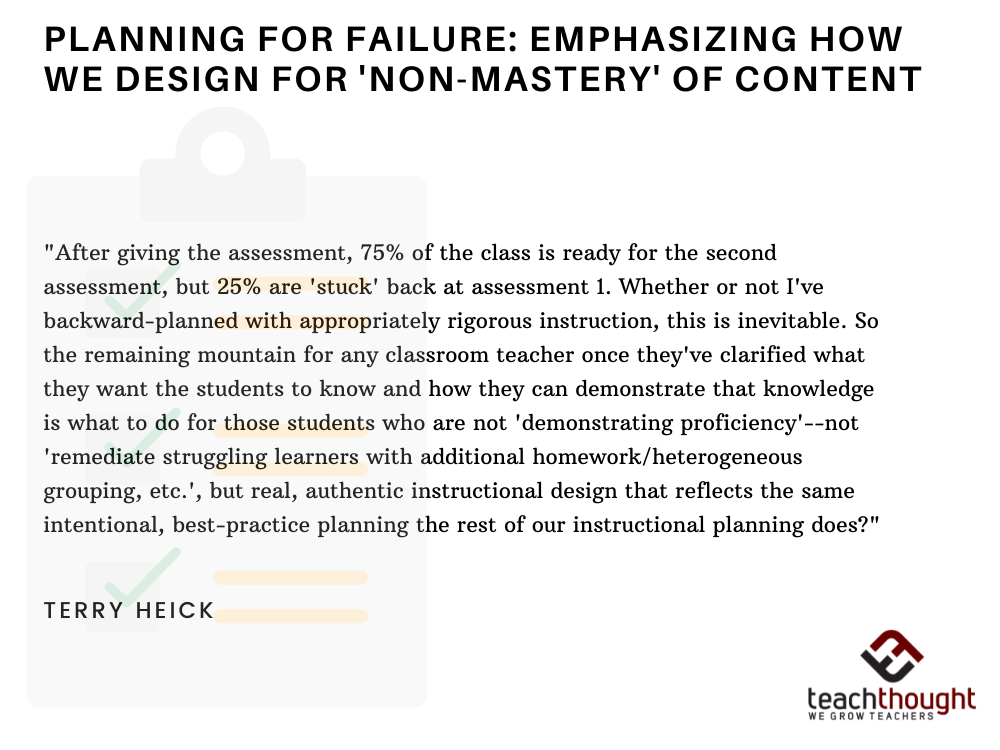It’s Time To Plan For Struggling Students From The Beginning
If I begin curriculum planning by identifying ‘power standards,’ where does the differentiation-based-on-assessment-results occur?
Planning For Struggling Students From The Beginning
by Terry Heick
The following post is excerpted from an email exchange between myself and the late Grant Wiggins years ago.
I’ve had a niggling question on how to more seamlessly and naturally integrate data into unit planning.
This question has surfaced for me in a variety of forms and insights–first with the concept of ‘power standards,’ then big ideas anchoring curriculum planning. At that point, the concept of summative assessments started seeming faulty to me: at what point is it ever best practice to accept non-mastery/confusion/failure/incongruity between performance and potential (or however you’d like to label less than ideal academic progress).
So in a classroom where there is a climate of assessment–with assessment simply indicators of where to go next for resources and alternative forms of assessments–why aren’t all assessments formative? All of these snapshots-of-understanding-as-data are useful, so why sit in the company of evidence of mastery and non-mastery, and continue planned instruction?
More precisely, how are we designing our activities/lessons/units to naturally absorb this data to inform the revision of those planned activities/lessons/units?
An Overview Of How We Plan
If I begin curriculum planning by identifying ‘power standards,’ designing big ideas and subsequent enduring understandings (using 40/40/40, among other local tools and initiatives/mandates), then deciding what forms of assessment will offer me the best evidence of those understandings (using 6 Facets of Understanding, again, among other tools), where does the differentiation-based-on-assessment-results occur?
Let’s say in an English-Language Arts classroom I design an assessment matrix or pattern of sorts where I would like for students to be able to explain the most significant difference between allegory and symbolism, then after a series of activities, three days later I’d like for them to apply what they’ve learned–e.g., use either allegory or symbolism to promote political propaganda based on audience and thesis.
After giving the assessment, 75% of the class is ready for the second assessment, but 25% are ‘stuck’ back at assessment 1. Whether or not I’ve backward-planned with appropriately rigorous instruction, this is inevitable. So the remaining mountain for any classroom teacher once they’ve clarified what they want the students to know and how they can demonstrate that knowledge is what to do for those students who are not ‘demonstrating proficiency’–not ‘remediate struggling learners with additional homework/heterogeneous grouping, etc.’, but real, authentic instructional design that reflects the same intentional, best-practice planning the rest of our instructional planning does?
Schools and districts are scrambling to develop ways to react to this very predictable quantity of non-proficiency (remediation, RTI, etc.), but this can be a ham-fisted, sledgehammer approach where all ‘non-proficient students’ are dealt with on the terms of that non-proficiency, often beyond the walls of their classroom, with other non-proficient peers, beyond the normal scope of school hours, etc., all requiring a tremendous investment of time and energy on the parts of everyone–a noble response to struggling learners, but might there not be a way to use curriculum and instructional planning to plan for this in a more natural, we-expected-this sort of way?
I keep envisioning some sort of revision to how we plan–adding something to our mapping, unit design, or lesson creation that pre-emptively plans and accommodates for non-proficiency from the beginning, rather than assuming all students will meet all learning targets, and then offering a mediocre response when they don’t (not because we’re lazy, but because personalizing the learning of 30+ students in an outcomes-based learning environment with curriculum maps made by someone else is essentially impossible).
A Flow Chart Of Understanding
Data is core to the instructional design process, so a sort of flowchart based on the results from an intentional assessment pattern makes sense, doesn’t it? There are countless ways teachers use to respond when students aren’t demonstrating those understandings–sometimes it’s as simple as giving another opportunity for the same assessment, offering a revised assessment, revised rubric, reduce the number of steps, alter the sequence of steps, etc.–but these are on the shoulders of the classroom teacher in real-time. It’s simply too much to expect from teachers on a daily basis.
(See also Diagnostic Teaching.)
I’m not suggesting that we completely remove this from the teacher’s shoulders (as I see two of a teacher’s primary roles as that of master of resources and assessment), but would like to have non-mastery intentionally planned for during the instructional design process so that non-mastery can be met with a planned, known, strategic and flexible response.
This isn’t about accepting non-proficiency (whatever that means), but rather planning for it from the beginning.
